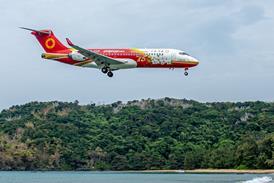US engine giant Pratt & Whitney has developed a number of joint-venture partners in the Asia-Pacific region including Chengdu Engine Group, Aviation Industries of China, China-National South Aero Engine and SIA Engineering, a subsidiary of Singapore Airlines.
The manufacturer is offering dependability, low cost of ownership, and low emissions for its PW4000 family now in service with 75 operators worldwide. More than 2,000 PW4000 engines are in service on the Airbus Industrie A300, A310 and A330 and the Boeing 747, 767, 777 and MD-11.
Advanced materials, such as single-crystal super alloys for higher temperature capability, and unique features, such as Pratt & Whitney's Floatwall combustor liners for improved durability and maintainability are being used.
The PW4000 family also provides outstanding environmental benefits, thanks in part to P&W's new-generation Talon - "Technology for Affordable Low NOx" - combustor.
Improvements
The Talon combustor's improved fuel-air mixing and the PW4000's single-row combustion have produced double-digit percentage improvements in NOx, CO and HC emissions.
The PW4000 family is approved for 180min Extended-range Twin-engine Operations (ETOPS) routes, giving aircraft equipped with PW4000 engines the ability to fly across oceans or barren terrain up to 3h from the nearest suitable airport.
The PW4000 family has three distinct versions.
Having made its first run in April 1984, the 94in -fan PW4000 was the first model in P&W's high-thrust family for large aircraft. It has been a leading choice of operators since its FAA certification in July 1986. The engine covers a thrust range of 52,000-62,000lb (230-275kN) and can be found on the widebody Airbus Industrie A300-600 and A310-300, Boeing 747-400, 767-200/300, and MD-11 aircraft.
More than 2,000 of these engines have accumulated over 40 million hours of service since June 1987, when the first engines were put into revenue service. The 94in -fan PW4000 fleet has flown more than 13 million hours of uninterrupted ETOPS service with 30 operators since September 1989.
Reliability
It has a dispatch reliability rate of 99.96% and a Shop Visit Rate of 0.073. This means that the average engine stays on wing 13,500 flight hours before a shop visit for any cause.
Besides providing reliable power and versatility, the engine is designed for low emissions and is one of the quietest engines on the market, with up to 1.7 to 3.4 dB cumulative margin advantage over competitors.
Building on the phenomenal success of the 94in-fan PW4000, P&W began developing a 100in-fan version in December 1991 to power the A330 wide-bodied twinjet. P&W's first high-thrust derivative, the 100in-fan PW4000 engine is now the market leader for the A330, having captured more than half the installed base. It provides a range of 64,000-68,000lb of thrust.
This PW4000 received FAA certification in August 1993 and made its first flight two months later. It received 90min ETOPS approval in December 1994, becoming the first engine in the industry to receive ETOPS approval upon entry into service. It received 180min ETOPS approval in July 1995.
The 100in-fan PW4000's service record is superb. Its leading market presence allowed the fleet to achieve one million hours of experience in January 2000, more than twice that of each competitor.
The third member of the PW4000 family, the 112in-fan version, is designed for the ultra-high-thrust market, covering the 84,000-98,000-pound-thrust range to meet the requirements of the powerful Boeing 777 twinjet. This model powers more Boeing 777 aircraft than either of its competitors.
Like the 100in-fan version, the 112in-fan PW4084 model made aviation history - it had already received approval for 180min ETOPS by the time it entered service in June 1995 and is the only engine with uninterrupted ETOPS operations on the 777.
Thrust
The 112in-fan PW4000's development began in October 1990 and actually achieved 100,000lb of thrust - another industry first - in May 1993.
The PW4090, with 90,000lb of thrust, entered service in March 1997. The PW4098, with 98,000lb of thrust, entered service in September 1999 on the Boeing 777-300 with 180min ETOPS.
The engine received FAA certification in July 1998.
Source: Flight Daily News























